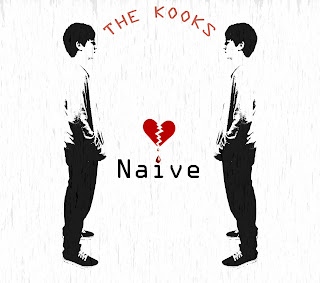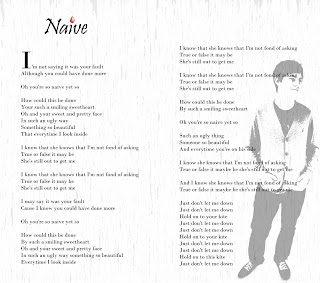Uses: We made a music video using some of the shots that we had seen in the videos of the kooks. For example we used mid shots which are commonly used within “The Kooks” videos and other videos from the indie/ alternative rock genre.
Narative Shots
 |
| Mid Shot |
 |
| Long Shot |
Performance Shots
Not only did we use similar technical aspects to our video but we also followed the conventions of a narrative to this music genre. We felt this was a safer option as we knew what was expected and we knew we could challenge other things during the music video. We followed the conventional use of footage balance between narrative and performance. This balance is commonly close to 50/50. We felt that this would be the best option because it would split up the narrative well but also put across the emotion and feelings commonly seen in performance shots.
Our mise-enscene throughout the video followed the conventions of similar music videos. We used a combination of indoors and outdoors during the filming which is typical to this genre. We also used similar props during filming, for example during the performance shots we used a guitar to illustrate the performance shots. Are costumes were also consistent to following conventions as we used similar clothes and accessories commonly associated with indie/alternative rock.
shots we used a guitar to illustrate the performance shots. Are costumes were also consistent to following conventions as we used similar clothes and accessories commonly associated with indie/alternative rock.
Develops: we developed the conventions of music videos of this genre in that we used a unusual combination of camera shots during the performance sections. What was different about these shots was that they were angled so you weren’t looking directly at the performer but your eye was drawn across the screen into the background where there was narrative within the performance shots. This may seem complicated but worked well. We also told quite a complicated story within our product which is unconventional to music videos. As you can see from the screen shots above of the performance shots they are angled so you have a wide depth of field, allowing the audience to see more of the surroundings and into the background.
We developed the idea of having instruments in the performance shots. We achieved this by using a guitar like mentioned earlier but had a character in the background playing it as opposed to the singer/performer using the guitar.
Challenge : We challenged it by blurring the barrier between the narrative and the performance shots as in the performance shots there was still the technical aspect of having a narrative within itself.
How effective is the combination of your main product and ancillary texts?
For our ancillary texts we designed and made a CD cover/ digi pack and an advertisement poster. Throughout every page in the digi pack and poster they all followed a set of simple but unique characteristics so the target audience can relate to it and remind them about it. This is a very effect form of advertisement as it jogs the target audience’s memory. An example of these characteristics follow…
 As you can see this is a very distinctive CD front cover. This is due to the high contrast between the black and white and the deep red. This is one characteristic that I’ve continued throughout the whole ancillary texts. Another characteristic is the silhouette/ stencil look of the main subject. This design is conventional to this genre of music and is a good representation of what you may expect from other texts.
As you can see this is a very distinctive CD front cover. This is due to the high contrast between the black and white and the deep red. This is one characteristic that I’ve continued throughout the whole ancillary texts. Another characteristic is the silhouette/ stencil look of the main subject. This design is conventional to this genre of music and is a good representation of what you may expect from other texts. This is the lyrics page to the digi pack, it’s clear to see that I have continued the characteristics I mentioned earlier into this section of the ancillary text. I also used a layer which almost dates the text by having random faint lines washed over the image
This is the lyrics page to the digi pack, it’s clear to see that I have continued the characteristics I mentioned earlier into this section of the ancillary text. I also used a layer which almost dates the text by having random faint lines washed over the imageMy final example of the characteristics is the advertisement poster. As you can see I have kept it very similar to the other ancillary texts just in the form of a poster. Of course there are differences and variations to the other texts. For example there is a more ‘open’ image which I felt was more eye catching for the audience. I’ve also included quotes from magazines about the single. This is also a very conventional technique used of posters.
The main media text (music video) links well to our ancillary texts because the main character in the music video is the face of all the ancillary texts. This gives the target audience an immediate link between the advertisement poster/CD cover and the music video. We also used similar clothing in the main text to which is used in the ancillary texts, helping create a link between the two products and also strengthening the presence of genre.
Finally, I have carried on the aged look in the main production. This has created a strong link between the ancillary tasks and the music video.
What have you learned from your audience feedback?
Through looking at our rough cut and showing it to our target audience we established that our narrative shots were too long and to frequent. This was a simple problem to fix as we just included more performance shots in order to compensate for the long scenes. Another constructive criticism we were faced with was the plot being a bit too complicated to follow during a music video. This was a bit more difficult to rectify as it meant cutting clips out which would jeopardise clarity within the narrative. We decided that the best way to rectify this issue was to re-film parts of the video to simplify the story line. I think if we were to do this project again we would keep the narrative simple and uncomplicated.
Another point which was brought up was the voice synchronising. Due to the performer not knowing the lyrics very well and not very familiar with the song it caused the syncing to be out when the final production was finished. This could have been rectified by re-filming the poor sections of the performance shots however this was too time consuming and would have put us behind on our production schedule.
How did you use new media technologies in the construction and research, planning and evaluation stages?
Construction : During the construction of our project we used high definition cameras to optimise digital footage and ensure out video was to a high standard. For the editing process we used two programmes. One of which is very advanced, Adobe Premiere Pro is a high end video editing programme which is perfect for short films or music videos. With a range of advanced features we were able to compile our video footage and begin editing minutes after filming. We used this programme to its full potential by including effects and adjusting the lighting settings within the programme. We also used a second editing software called I-Movie which is a more basic editing programme but we found it much easier and quicker to synchronise the audio track with our video footage. This synchronising process was possible in Adobe Premiere Pro but was to lengthily and time consuming to do it. So to optimise time management and available resources we decided to continue synchronising in I-Movie.
Research & Planning : With the internet at our fingertips at almost any given moment, it seemed the best and most efficient way of researching and planning our project. We used the internet (web 2.0) to look into a range of genres and artiest before we finalised on indie/ alternative rock and more specifically ‘The Kooks’. With the help of websites such as ‘YouTube’ and bands official web sites we gained a good knowledge and understanding about what it takes to make a music video. We documented all our research and planning on online blogs provided by www.blogger.com which is a Google based company. We were able to use blogger to its full technical ability by imbedding documents such as PowerPoint which we had made and uploaded via a site called www.scribed.com. We were also able to embed YouTube videos and create links to other blogs/ blog posts.




No comments:
Post a Comment